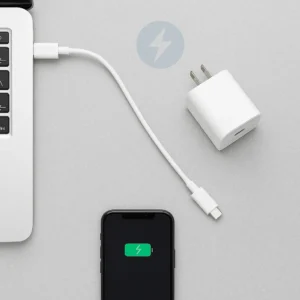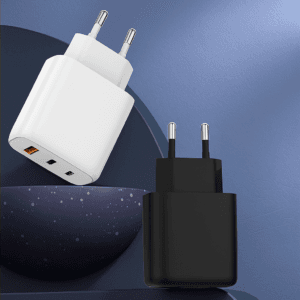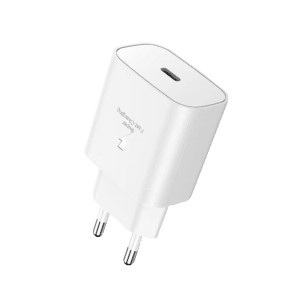À medida que a demanda por carregamento rápido e eletrônicos de baixo consumo de energia acelera em todos os setores, o USB Power Delivery (USB PD) emergiu como o padrão universal. Seja para adquirir carregadores, cabos ou sistemas embarcados para produção OEM/ODM, entender o ecossistema USB PD agora é essencial. vantagem crítica para compradores.
Esta lista de verificação descreve tudo o que você precisa saber sobre USB Protocolos de DP, especificações, e conformidade dos componentes à medida que avançamos para 2025.
Fornecimento de energia USB: uma visão geral
USB PD (Entrega de Energia) é um protocolo flexível de negociação de carga e energia incorporado ao Conector USB-C. Permite que os dispositivos selecionem dinamicamente a tensão e a corrente de carga, fornecendo até 240 W sob o USB PD 3.1 especificação.
Principais benefícios: Um cabo para ambos dados e energia. Negociação de fornecimento de energia com base nos requisitos do dispositivo. Suporta carregamento bidirecional. Habilita carregamento rápido para laptops, telefones, monitores e muito mais
Evolução dos protocolos USB PD

Dica do comprador: sempre confirme se a solução do seu fornecedor oferece suporte a USB PD 3.1 com recursos AVS (fonte de tensão ajustável) e PPS (fonte de alimentação programável).
USB-C: A espinha dorsal do hardware
O USB PD requer o Conector USB tipo C, conhecido por: Design de plugue reversível. Alta capacidade de corrente (até 5A). Integração com Padrões de dados USB 3.1 e USB 4
Para segurança e conformidade, solicite: Cabos USB-C com marcação E (para uso >3A). Certificação USB-IF para todos os cabos e portas USB
Carregamento rápido e fonte de alimentação programável (PPS)
Carregamento rápido A tecnologia USB PD permite que smartphones e laptops atinjam uma carga de 50–70% em menos de 30 minutos. O PPS adiciona ainda mais refinamento com controle de tensão/corrente em tempo real, reduzindo o calor e o estresse da bateria. Ideal para dispositivos como a série Samsung Galaxy S/Note, Xiaomi e laptops mais recentes com suporte a PPS.
Procurar: Carregadores GaN com PPS. Portas USB-C rotuladas como “PD/PPS”. Suporte para Saída ajustável de 5 V–20 V
Carregadores USB PD multiportas e GaN
Os carregadores USB PD multiportas permitem carregando vários dispositivos simultaneamente sem comprometer a velocidade ou a potência. Combinando protocolos de DP com GaN (Nitreto de Gálio) A tecnologia melhora: Eficiência. Redução de tamanho. Gerenciamento térmico.
Lista de verificação do comprador: Todas as portas USB-C Habilitado para PD? É GaN usado para melhor desempenho térmico? As portas são isoladas para carregamento seguro de vários dispositivos?
Testes e Certificação de Conformidade
Para importadores e OEMs, a conformidade garante ambos desempenho e segurança jurídica.
O que verificar: Certificação USB-IF para carregadores, cabos, controlador. Passes Conjunto de testes de conformidade USB PD (CTS). Cabos USB-C com marcação E. Proteção contra sobretensão e segurança contra curto-circuito
Recomendado: Solicite relatórios de conformidade ou resultados de testes antes de pedidos em grandes quantidades.
Considerações sobre terceirização B2B para 2025
Antes de fazer seu próximo pedido de produto USB PD, certifique-se de que seu fornecedor cobre: Suporte PD 3.1 até 240 W. Funcionalidade PPS para as principais marcas de smartphones. Certificação USB-IF para todos os cabos. Integração de chip GaN para eficiência térmica. Saída PD multiporta. Disponibilidade de Controladores PD para produtos embarcados. Cabo USB-C de qualidade (marcação E, blindado, certificado). Suporte para negociação de tensão com AVS
Considerações finais
À medida que o USB PD se torna o padrão global de carregamento, os compradores devem avaliar não apenas a potência, mas também a protocolos, conformidade, e design térmico atrás de cada dispositivo USB-C.
Se você está terceirizando Carregadores USB-C, soluções de energia programáveis ou sistemas PD incorporados, certifique-se de que seus fornecedores atendem aos padrões USB PD mais recentes e oferecer certificações adequadas.





